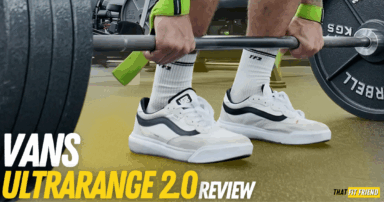Don’t sleep on sumo RDLs. Your hips, hamstrings, and glutes will thank you for adding more of these into your program.
I’ve found the Sumo RDL to be one of the most underutilized yet effective posterior chain exercises in my toolbox. I’ve used this movement to work around knee injuries with both me and my clients and help powerlifters break through plateaus.
In my early days of coaching, I actually didn’t program Sumo RDLs a ton because I thought the traditional RDL was enough.
I’ve since changed this tune and LOVE using sumo RDLs for my hips and just providing my body with a different stimulus in general. To be honest, I regret not programming them a lot more when beginning my lifting journey.
How to Perform the Sumo RDL
Step 1: Nail the Setup
Your initial sumo RDL position sets the foundation for effective reps. You can perform sumo RDLs with dumbbells, kettlebells, or a traditional barbell.
Coaching Cues: Take a wide stance, slightly narrower than your competition’s sumo position. I suggest doing this because you still need to be able to maintain a hinge position. If it is too wide, you’ll limit hip loading and drive. Start from the ground or a rack.

- Equipment options:
- Barbells: Best for progressive overload
- Dumbbells: Ideal for learning movement pattern
- Kettlebells: Great for grip variation
- Foot pressure tips:
- Use tripod foot position with balanced pressure
- Experiment with pressure
Step 2: Hips Back, Chase the Stretch
The hinge is huge for maximizing the stretch on your hamstrings and glutes. You may need to play with your stance a bit, so don’t be afraid to adjust as you go and your weight gets heavier.
Coaching Cues: Think about pushing your hips straight back as if I’m pulling them with a string behind you while maintaining a rigid position with your upper body. Maintain a soft knee bend based on your anatomy and let the bar track around mid-foot.

- Key positions:
- Hips translate directly back
- Upper body stays tight
- Knees slightly bent
- Continue until you feel a maximal stretch, ROMs can vary
- Common errors:
- Too much knee bend and turn reps too “squatty” which can create a loss in hamstrings tension
- Quick Fixes:
- Film from side angle
- Maintain higher hip position
Step 3: Ascend, Squeeze the Glutes
Don’t rush your reps. I know, I know, the mind-muscle connection isn’t necessarily mainstream accepted, but I think there is merit in slowing down and connecting your intent with your reps when hitting sumo RDLs.
Coaching Cues: Push the hips forward toward the bar and squeeze the glutes and hamstrings as you ascend. Drive the hips forward at lockout and lock out with glute emphasis.

Torso and head position:
- Lighter weights allow for more extended position
- Heavier loads benefit from neutral stack
- Starting points:
- Gaze 10-12 feet ahead
- Allow natural position adjustments
- Don’t force uncomfortable positions
Benefits and Why They’re Great
1. They Give You Stance Variation
The wider stance creates a unique training stimulus for posterior chain development. I think more athletes and lifters need to make points to put themselves into different and “sub-optimal” positions.
The sumo RDL is great because it allows us to change to a different type of hinge than what we traditionally do with RDLs. When was the last time you picked something up off the ground in the real world with a wider stance? Probably more often than what you use in a traditional RDL.
More and more, I’m approaching my training with the mindset of “creating variety with training” and loading different positions (within reason). Your body will thank you.

2. Sumo Deadlift Carryover
If you tug sumo, then it shouldn’t come as a surprise to you that the sumo RDL can create a nice carryover for your pull. Just like how RDLs create a nice carryover for traditional barbell deadlifts.
The sumo RDL can be super beneficial for lifters who are struggling with their sumo RDL lockout. With its eccentric and lockout bias, it can be a great option if you constantly feel like you’re running out of gas as you pass the knee with your sumo deadlifts.
Not to mention, you’ll be training the hamstrings, glutes, and hip hinge through a very specific range of motion that can easily be modified, which may not be as easy to do with your normal sumo deadlift reps.
3. Great for Working Around Knee Injuries
I’m a professional knee rehabber at this point in my career (ruptured quad, a few quad tendon strains), and the sumo RDL is one of my foolproof posterior-focused exercises that never creates issues on cranky knees.
If you’re constantly navigating stiff or tight knees but still want to train the glutes and hamstrings, give the sumo RDL a try. Modify your range of motion and intensity per your needs.
Programming Tips
The easiest way to add Sumo RDLs into your program is to add them to your posterior-focused days. Use them as a main accessory or even as a warm-up.
- Programming suggestions:
- Sets and Reps: 3-4 sets of 8-12 reps
- Intensity: Ascending load from 3-4 RIR to 1-2 RIR, top set to close to failure.








Add a Comment